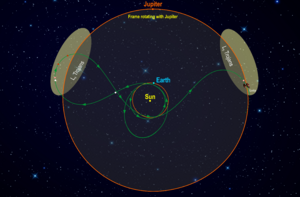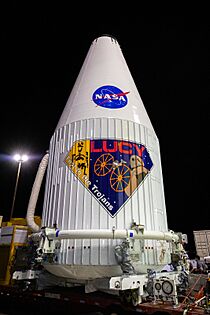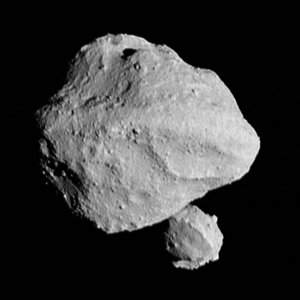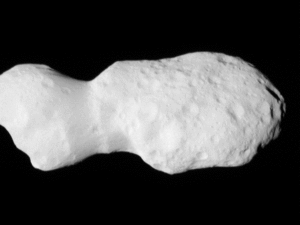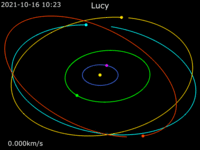Lucy (spacecraft) facts for kids
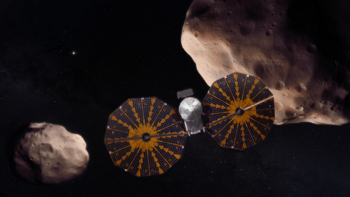
Artist's conception of Lucy spacecraft flying past the Trojan asteroid 617 Patroclus and its binary companion Menoetius
|
|
| Names | Discovery Mission 13 |
|---|---|
| Mission type | Multiple-flyby of asteroids |
| Operator | NASA Goddard · SwRI |
| Mission duration | 12 years (planned) 4 years, 2 months and 4 days (in progress) |
| Spacecraft properties | |
| Manufacturer | Lockheed Martin |
| Launch mass | 1,550 kg (3,420 lb) |
| Dry mass | 821 kg (1,810 lb) |
| Dimensions | 13 m (43 ft) in long Each solar panel: 7.3 m (24 ft) in diameter |
| Power | 504 watts (furthest encounter) |
| Start of mission | |
| Launch date | 16 October 2021, 09:34 UTC |
| Rocket | Atlas V 401 (AV-096) |
| Launch site | Cape Canaveral SLC-41 |
| Contractor | United Launch Alliance |
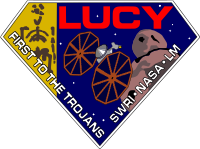 Lucy mission patch |
|
The Lucy spacecraft is a special robot explorer from NASA. It is on a twelve-year trip to study eight different space rocks called asteroids. Lucy will visit two asteroids in the main asteroid belt. It will also visit six Jupiter trojans. These are asteroids that share Jupiter's path around the Sun. They orbit either ahead of or behind Jupiter.
Lucy was launched on October 16, 2021. It is part of NASA's Discovery Program. The mission is named after the famous Lucy fossil. This fossil helped scientists learn about early human history. Similarly, studying the Trojan asteroids can teach us about the early Solar System. These asteroids are like "fossils of planet formation." They are leftover materials that formed planets long ago. The original Lucy fossil was named after a Beatles song, "Lucy in the Sky with Diamonds". The spacecraft even carries a special disc made of lab-grown diamonds.
Contents
Lucy Spacecraft: An Overview
Lucy blasted off from Cape Canaveral in Florida. This happened on October 16, 2021. It launched on an Atlas V rocket. The spacecraft used Earth's gravity to help it speed up. This is called a gravity assist. It got one gravity assist on October 16, 2022. It got another one in 2024.
In November 2023, Lucy flew past an asteroid named Dinkinesh. In April 2025, it flew past another asteroid called Donaldjohanson. This asteroid was named after the person who discovered the Lucy fossil.
Lucy is now heading towards the L4 Trojan cloud. This group of asteroids orbits about 60 degrees ahead of Jupiter. It will arrive there in August 2027. It will fly past four Trojans: Eurybates (which has a moon), Polymele, Leucus, and Orus.
After these flybys, Lucy will return to Earth in 2031. It will get another gravity assist. This will send it towards the L5 Trojan cloud. This group of asteroids trails about 60 degrees behind Jupiter. In 2033, Lucy will visit a binary Trojan called Patroclus. Patroclus has a companion asteroid named Menoetius.
Scientists want to explore Jupiter Trojans because they are very old. They are "dark" and do not reflect much sunlight. Jupiter is about five times farther from the Sun than Earth is. The Trojans are at a similar distance. There might be as many Trojans as there are asteroids in the main belt.
How Lucy Was Developed
NASA chose Lucy for its Discovery Program. This program looks for new space missions. Lucy was one of many ideas submitted in 2015. The proposals had to be ready to launch by the end of 2021. Twenty-eight different ideas were sent in.
In September 2015, Lucy was picked as one of five finalists. Each finalist received money to plan their mission in more detail. On January 4, 2017, Lucy and another mission called Psyche were chosen to be built and launched.
NASA announced in January 2019 that Lucy would launch in October 2021. It would use an Atlas V rocket from Cape Canaveral, Florida. The launch cost was about $148.3 million.
In August 2020, NASA gave Lucy the "green light" to start building and testing the spacecraft. The instruments for Lucy began arriving in October 2020. In July 2021, the spacecraft was flown to Florida for launch. It was placed inside the rocket on September 30, 2021. Lucy successfully launched on October 16, 2021.
Lucy's Science Tools
Lucy carries three main science tools, also called instruments:
- L'Ralph – This instrument takes pictures in visible light and infrared light. It helps scientists see what the asteroid surfaces are made of. It can detect things like silicates, ice, and organic materials. L'Ralph is similar to an instrument on the New Horizons spacecraft.
- L'LORRI – This is a high-resolution camera. It takes very detailed pictures. L'LORRI is based on a camera from the New Horizons mission. It will give us the clearest views of the Trojan asteroid surfaces.
- L'TES – This is a thermal infrared spectrometer. It measures the heat coming from the asteroids. This helps scientists understand the temperature and what the surface materials are like. L'TES is similar to an instrument on the OSIRIS-REx mission. Because Trojan asteroids are very cold, L'TES will mainly study their surface properties.
- Radio Science – Lucy also uses its radio to learn about the asteroids. By measuring small changes in the radio signal, scientists can figure out how heavy the asteroids are.
- T2CAM – This is a special camera used to track the asteroids. It takes wide-field images to help scientists understand the shapes of the asteroids.
Golden Plaque on Board
Lucy carries a special golden plaque. It has the launch date and the positions of the planets. It also shows Earth's continents at the time of launch. The plaque includes twenty speeches, poems, and song lyrics. These messages are from people like Martin Luther King Jr. and Carl Sagan. Since Lucy will stay in the Solar System, there's a chance future humans might find it.
Lucy's Journey and Targets
Lucy's path was planned to visit as many different asteroids as possible. The journey includes flying by Earth multiple times. These flybys give Lucy a "gravity assist," which helps it speed up. It also includes a big maneuver in deep space.
Here are the specific objects Lucy has visited or will visit:
| Encounter date | Target | Group | Diameter | Altitude | Classification | Comment |
|---|---|---|---|---|---|---|
| 16 October 2022 | Earth | Terrestrial planets | 12742 km | 300 km | Terrestrial planet | Gravity assist |
| 1 November 2023 | 152830 Dinkinesh | Inner main belt | Dinkinesh: 0.7 km (Selam satellite: 0.2 km) |
425 km | Binary S-type asteroid | Smallest target of the mission. |
| 13 December 2024 | Earth | Terrestrial planets | 12742 km | 350 km | Terrestrial planet | Gravity assist |
| 20 April 2025 | 52246 Donaldjohanson | Inner main belt | 4 km | 960 km | C-type asteroid | Part of a family of asteroids formed from a collision. |
| 12 August 2027 | 3548 Eurybates | Greek camp at L4 | Eurybates: 64 km (Queta satellite: 1 km) |
720 km | Binary C-type asteroid | Largest member of a unique asteroid family in the Trojans. |
| 15 September 2027 | 15094 Polymele | Greek camp at L4 | Polymele: 21 km (Satellite: 5 km) |
415 km | Binary P-type asteroid | Its red color suggests it has organic compounds. |
| 18 April 2028 | 11351 Leucus | Greek camp at L4 | 34 km | 1000 km | D-type asteroid | It spins very slowly, taking 466 hours for one rotation. |
| 11 November 2028 | 21900 Orus | Greek camp at L4 | 51 km | 1000 km | D-type or C-type asteroid | Possibly a binary system. |
| 26 December 2030 | Earth | Terrestrial planets | 12742 km | 660 km | Terrestrial planet | Gravity assist. This will be the first time a spacecraft returns to Earth from beyond Jupiter's orbit. |
| 2 March 2033 | 617 Patroclus–Menoetius | Trojan camp at L5 | Patroclus: 113 km Menoetius: 104 km |
1000 km | Binary P-type asteroids | These two asteroids orbit each other. |
Lucy's Journey So Far
Lucy began its space journey on October 16, 2021. It launched on an Atlas V rocket. The rocket first put Lucy into a low orbit around Earth. Then, the rocket's second stage fired again. This pushed Lucy onto its path towards the asteroids. The mission is planned to last twelve years. If Lucy is still working well after that, its mission might be extended to visit even more asteroids.
Solar Panel Challenge
On launch day, Lucy started to open its two large solar panels. These panels collect sunlight to power the spacecraft. One of the solar panels did not fully lock into place. NASA confirmed that the spacecraft was still "safe and stable." Tests showed the panel was between 75% and 95% open.
By January 2022, NASA found the reason for the problem. Even with the panel not fully locked, Lucy was still getting enough power. Scientists decided to try to fix it later. In May 2022, Lucy tried a small step to complete the deployment. This helped the team understand the problem better. By August 2022, NASA reported that the solar array was mostly open (between 353 and 357 degrees out of 360). It was stable enough for the mission to continue. After another attempt in December 2022, the team decided to stop further work on the solar panels.
Flyby of Dinkinesh
On January 25, 2023, NASA announced that Lucy would fly by a small asteroid called Dinkinesh. This asteroid was not originally a target because it was thought to be too small. But Lucys path took it close enough. Scientists adjusted Lucys trajectory to get an even closer look.
On November 1, 2023, Lucy successfully flew past Dinkinesh. The next day, NASA shared images from the flyby. They announced that Dinkinesh had a small moon! The first pictures showed Dinkinesh was about 790 meters (about half a mile) wide. Its moon was about 220 meters (about a quarter-mile) wide. Later images showed that the moon was actually two objects touching each other. This is called a contact binary. With this discovery, Lucy now has eleven planned asteroid visits.
Flyby of Donaldjohanson
Lucy first saw Donaldjohanson on February 25, 2025. It was very far away at that time.
On April 20, 2025, the spacecraft successfully flew past Donaldjohanson. It passed about 960 kilometers (about 600 miles) away. This flyby was like a "dress rehearsal" for Lucy's main encounters with the Trojan asteroids. During the flyby, Lucy tracked Donaldjohanson on its own. It even turned its antenna away from Earth to protect its instruments from the Sun.
The first images released the next day showed that Donaldjohanson was also a contact binary. It was larger than expected, about 8 kilometers (5 miles) long and 3.5 kilometers (2 miles) wide.
Images for kids
See also
 In Spanish: Lucy (sonda espacial) para niños
In Spanish: Lucy (sonda espacial) para niños







